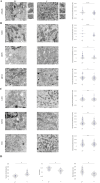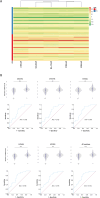Novel biomarkers of mitochondrial dysfunction in Long COVID patients
- PMID: 39495479
- PMCID: PMC11979091
- DOI: 10.1007/s11357-024-01398-4
Novel biomarkers of mitochondrial dysfunction in Long COVID patients
Abstract
Coronavirus disease 2019 (COVID-19) can lead to severe acute respiratory syndrome, and while most individuals recover within weeks, approximately 30-40% experience persistent symptoms collectively known as Long COVID, post-COVID-19 syndrome, or post-acute sequelae of severe acute respiratory syndrome coronavirus 2 (SARS-CoV-2) infection (PASC). These enduring symptoms, including fatigue, respiratory difficulties, body pain, short-term memory loss, concentration issues, and sleep disturbances, can persist for months. According to recent studies, SARS-CoV-2 infection causes prolonged disruptions in mitochondrial function, significantly altering cellular energy metabolism. Our research employed transmission electron microscopy to reveal distinct mitochondrial structural abnormalities in Long COVID patients, notably including significant swelling, disrupted cristae, and an overall irregular morphology, which collectively indicates severe mitochondrial distress. We noted increased levels of superoxide dismutase 1 which signals oxidative stress and elevated autophagy-related 4B cysteine peptidase levels, indicating disruptions in mitophagy. Importantly, our analysis also identified reduced levels of circulating cell-free mitochondrial DNA (ccf-mtDNA) in these patients, serving as a novel biomarker for the condition. These findings underscore the crucial role of persistent mitochondrial dysfunction in the pathogenesis of Long COVID. Further exploration of the cellular and molecular mechanisms underlying post-viral mitochondrial dysfunction is critical, particularly to understand the roles of autoimmune reactions and the reactivation of latent viruses in perpetuating these conditions. This comprehensive understanding could pave the way for targeted therapeutic interventions designed to alleviate the chronic impacts of Long COVID. By utilizing circulating ccf-mtDNA and other novel mitochondrial biomarkers, we can enhance our diagnostic capabilities and improve the management of this complex syndrome.
Keywords: Mitochondria; Mitophagy; Oxidative damage; Post-COVID; mtDNA.
© 2024. The Author(s).
Conflict of interest statement
Declarations. Competing interests: Dr. Andrea Lehoczki serves as Associate Editor for Geroscience. Dr. Barbara N. Borsos serves as an official lector who corrected the manuscript.
Figures



References
-
- World Health Organization. WHO COVID-19 dashboard. https://data.who.int/dashboards/covid19/deaths?n=o. Accessed on 07/08/2024.
-
- Peterfi A, Meszaros A, Szarvas Z, Penzes M, Fekete M, Feher A, Lehoczki A, Csipo T, Fazekas-Pongor V. Comorbidities and increased mortality of COVID-19 among the elderly: a systematic review. Physiol Int. 2022. 10.1556/2060.2022.00206. - PubMed
-
- Fekete M, Szarvas Z, Fazekas-Pongor V, Feher A, Dosa N, Lehoczki A, Tarantini S, Varga JT. COVID-19 infection in patients with chronic obstructive pulmonary disease: from pathophysiology to therapy. Mini-review. Physiol Int. 2022. 10.1556/2060.2022.00172. - PubMed
-
- Feher A, Szarvas Z, Lehoczki A, Fekete M, Fazekas-Pongor V. Co-infections in COVID-19 patients and correlation with mortality rate. Minireview. Physiol Int. 2022. 10.1556/2060.2022.00015. - PubMed
MeSH terms
Substances
Grants and funding
- NKFI-FK 132080/Nemzeti Kutatási Fejlesztési és Innovációs Hivatal
- RRF-2.3.1-21-2022-00003/Nemzeti Kutatási Fejlesztési és Innovációs Hivatal
- 739593/Horizon 2020 Framework Programme
- TKP-2021-EGA-05/Nemzeti Kutatási, Fejlesztési és Innovaciós Alap
- 2022-2.1.1-NL-2022-00005/Nemzeti Kutatási, Fejlesztési és Innovaciós Alap
LinkOut - more resources
Full Text Sources
Medical
Miscellaneous

